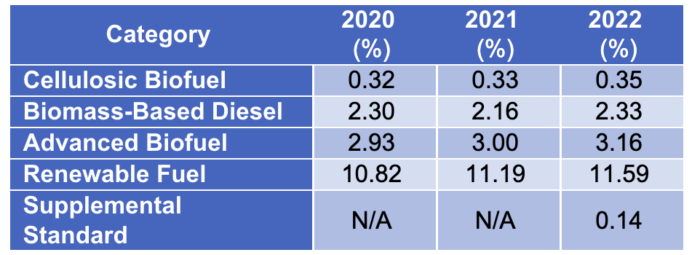RFS Standards for 2020, 2021, 2022
Link to article: https://stillwaterassociates.com/rfs-standards-for-2020-2021-2022/
September 5, 2022
by Adam Schubert & Mike Leister
On July 1, 2022, the U.S. Environmental Protection Agency (EPA) established the final Renewable Fuel Standard (RFS) percentage standard requirements for 2020, 2021, and 2022. These percentages – which are displayed in Table 1 below – were calculated using the renewable identification number (RIN) quantities in Table 2, further below.
Table 1. Final RFS percentage standards

Table 2. Final RFS RIN Volume Requirements (billion RINs)

*The BBD volume is in physical gallons rather than RINs
Table 3 shows the total projected volumes of gasoline and diesel that EPA used for these RFS obligation calculations. Since 2020 and 2021 have already ended, EPA is setting the percentage and RIN volume requirements based on the actual renewables, gasoline, and diesel consumed in those years; for 2022, EPA is setting the RIN volume and percentage standards higher than previous years for all four categories. Of significance are the increase in biomass-based diesel (BBD) from 2.43 to 2.76 billion gallons and the increase in conventional biofuels from 13.79 to 15.0 billion gallons.
Table 3. Gasoline and Diesel Volumes Used in EPA’s Calculations, billion gallons

For 2022, EPA has added a new supplemental obligation of 250 million RINs in order to meet a court-ordered remand requirement. EPA also announced their intention to establish the same supplemental obligation for 2023. For 2022, EPA has opted to reset the cellulosic biofuel, advanced biofuel and total renewable fuel targets since, as outlined in the RFS2 statute, the original targets have been missed by 20% two years in a row or 50% in a single year.
The defined RFS2 annual volume standards specified in statute by Congress in 2007 only go through 2022; in future years, EPA will be required to set the four standards without the need to establish and justify why they are setting standards differing from those mandated in the statute.
In the July 1, 2022 rule, EPA states that they anticipate that there will be no small refinery exemptions for 2022.
In this rulemaking, EPA is also changing how biointermediates will be handled. Previously, for a biofuel to be considered for inclusion under the RFS it had to be produced and processed in a single facility. EPA is now allowing for the creation of biointermediates, such as biocrude, to be created and produced in one facility and used to generate RINs by being processed in a second facility, such as a refinery. In order to operate over two facilities, EPA is extending the RFS Quality Assurance Plan (QAP), auditing, attest engagement, and product transfer document (PTD) requirements to cover both facilities in order to assure that biofuels are not double counted.
This rule also contains many “housekeeping” adjustments to RFS definitions that RFS compliance personnel should be aware of.
Separately, on August 22nd, EPA announced the prices of Cellulosic Waiver Credits (CWCs) for 2021 and 2022 as $2.23 and $2.31, respectively.1 Recall, that EPA offers CWCs in years when the Cellulosic Biofuels volume standard is set at levels below those defined in statute. Obligated parties under the RFS have the option to purchase CWCs from EPA as an alternative to acquiring a cellulosic (D3) RIN. As CWCs do not satisfy the obligated party’s Advanced Biofuels obligation, parties using CWCs to meet their obligations need to also acquire a D5 (Advanced Biofuel) RIN for each CWC they acquire; this effectively creates a price ceiling for D3 RINs at the sum of the CWC price and the cost of a D5 RIN.
Additional questions on RFS requirements or RINs? Contact us!
Did you know we offer RINs price outlooks? Contact us to learn more!
Categories: Uncategorized
